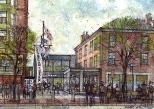Projected to open in 2005, the new facility at 450-452 Massachusetts Ave. near the intersection of Brookline Street will contain more than 9,000 square feet including a 175-seat black box theater, rehearsal space, box office and other amenities for the two theater companies. The theater space will be part of a larger structure to be built by MIT on the site of the vacant Bradford Building, the oldest building in Central Square and the second-oldest building in Cambridgeport.
"The City of Cambridge is very excited that MIT is taking steps to redevelop the historic Bradford Cafe site in Central Square. We're also glad to learn that the Institute is working closely with the Nora Theatre Company and Underground Railway Theater to create a new home for live theater in the Square," said City Manager Robert W. Healy. "The theater groups will be a great match for Central Square, furthering the city's goal of keeping the area lively at night and supporting the area's already vibrant restaurant and entertainment scene."
Founded in 1988, the Nora produces contemporary theater and modern classics, and champions the voice of women. To date, the company has staged 44 productions of contemporary and modern classic works, including 25 Boston-area premieres. Underground Railway Theater (URT), founded 25 years ago, features actors, puppetry and music and seeks to connect high-quality professional theater with communities through original plays and rigorous educational programming. The company has made a specialty of crossing disciplines and creating theater of great visual beauty and social content.
Neither the Nora nor URT has ever had a permanent home. Both approached MIT several years ago, asking to collaborate on a proposed theater facility at the Bradford Cafe site. In an effort to contribute to the ongoing revitalization of the Central Square area, MIT offered a favorable per-square-foot rental rate that is significantly below market, plus a tenant allowance to help them build out the space.
"We realized that together we could accomplish much more than we ever could independently, both in terms of programming and theater management," the groups' artistic directors, Mary C. Huntington of the Nora and Debra Wise of URT, said in a joint announcement. "We share a vision: theater is integral to the quality of life, it illuminates the resilience of the human spirit, and it promotes understanding and tolerance by embracing diversity and bridging cultural divides. None of this would be possible without the cooperation of the City of Cambridge and MIT. They have steadfastly worked with us to make this lease-signing a reality."
MIT Executive Vice President John R. Curry said, "MIT sees the theaters, as well as our own restoration of the historic Bradford Building, as another space in the bridge between the Institute and the City, and as a magnet attracting Cambridge residents towards the campus and attracting MIT students, faculty and staff towards the increasingly vital Central Square. This is a three-way win -- for the City, the arts and MIT -- achieved through hard work and goodwill."
The Bradford Building is part of South Row, the surviving element in a three-story, hip-roofed Federal-period row built in 1806 by Chief Justice Francis Dana, a major landowner in Cambridgeport. Charles Sullivan, executive director of the Cambridge Historical Commission, called South Row "the most significant early building in Cambridgeport," not only for its age, but because it was the intended prototype for the commercial development of Central Square. As a commercial building dating from the Federal period, South Row is a rarity in Cambridge. "MIT is making a major contribution to historic preservation as well as to the performing arts," Sullivan said.
Although MIT is known for its science and engineering research, it also has rich and varied offerings in the performing arts, including a vibrant theater arts program in which enrollment has jumped 300 per cent since 1988. Hundreds of free performances, exhibitions and readings each year enrich campus life while drawing visitors from throughout greater Boston.
"I'm proud of our ability to provide the theater companies with a home, not only because of their quality but because of the model of collaboration and cooperation their plans represent," said Alan Brody, MIT's associate provost for the arts and an award-winning playwright. "They are responding to these difficult times with thoughtful and creative solutions and I look forward to even closer relations with both organizations as they settle into their new home."
While MIT works with Central Square firm Pfeufer/Richardson, P.C. Architects on the permitting process and building design, the theater companies will be meeting with community groups to share ideas on collaborative cultural and educational projects and raising $2 million. "We want to make a positive difference in the lives of those who reside and work in the city," Huntington and Wise said.






